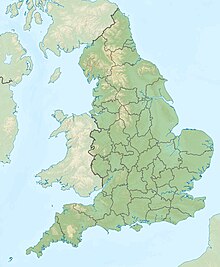| Battle of Evesham | |||||||
|---|---|---|---|---|---|---|---|
| Part of Second Barons' War | |||||||
 Death and mutilation of de Montfort at the Battle of Evesham | |||||||
| |||||||
| Belligerents | |||||||
| Royal forces |
Baronial forces Kingdom of Gwynedd | ||||||
| Commanders and leaders | |||||||
|
Prince Edward Gilbert de Clare Humphrey de Bohun John de Warenne William de Valence Roger Mortimer |
Simon de Montfort † Henry de Montfort † Guy de Montfort (POW) Peter de Montfort † Nicholas de Segrave (POW) Humphrey (V) de Bohun (POW) Hugh le Despenser † | ||||||
| Strength | |||||||
| c. 10,000 | c. 5,000 | ||||||
| Casualties and losses | |||||||
| Few | Nearly 4,000[1] | ||||||
Location within England | |||||||
The Battle of Evesham (4 August 1265) was one of the two main battles of 13th century England's Second Barons' War. It marked the defeat of Simon de Montfort, Earl of Leicester, and the rebellious barons by the future King Edward I, who led the forces of his father, King Henry III. It took place on 4 August 1265, near the town of Evesham, Worcestershire.
With the Battle of Lewes, de Montfort had won control of royal government, but after the defection of several close allies and the escape from captivity of Prince Edward, he found himself on the defensive. Forced to engage the royalists at Evesham, he faced an army twice the size of his own. The battle soon turned into a massacre; de Montfort himself was killed and his body mutilated. It was described by the contemporary historian Robert of Gloucester as the "murder of Evesham, for battle it was none".[2] Though the battle effectively restored royal authority, scattered resistance remained until the Dictum of Kenilworth was signed in 1267.
